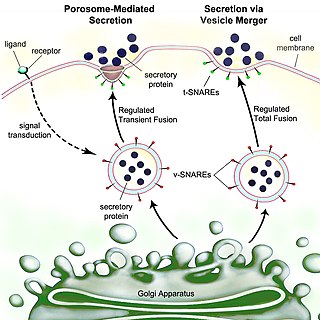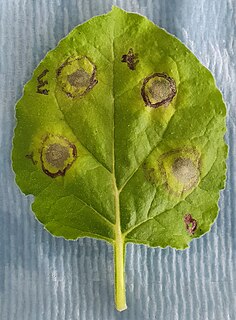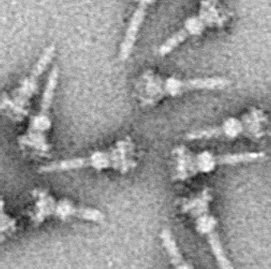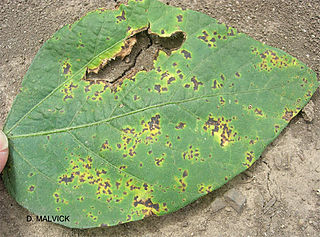Related Research Articles

Secretion is the movement of material from one point to another, such as a secreted chemical substance from a cell or gland. In contrast, excretion is the removal of certain substances or waste products from a cell or organism. The classical mechanism of cell secretion is via secretory portals at the plasma membrane called porosomes. Porosomes are permanent cup-shaped lipoprotein structures embedded in the cell membrane, where secretory vesicles transiently dock and fuse to release intra-vesicular contents from the cell.

Φ6 is the best-studied bacteriophage of the virus family Cystoviridae. It infects Pseudomonas bacteria. It has a three-part, segmented, double-stranded RNA genome, totalling ~13.5 kb in length. Φ6 and its relatives have a lipid membrane around their nucleocapsid, a rare trait among bacteriophages. It is a lytic phage, though under certain circumstances has been observed to display a delay in lysis which may be described as a "carrier state".
Virulence factors are cellular structures, molecules and regulatory systems that enable microbial pathogens to achieve the following:
Cytolysin refers to the substance secreted by microorganisms, plants or animals that is specifically toxic to individual cells, in many cases causing their dissolution through lysis. Cytolysins that have a specific action for certain cells are named accordingly. For instance, the cytolysins responsible for the destruction of red blood cells, thereby liberating hemoglobins, are named hemolysins, and so on. Cytolysins may be involved in immunity as well as in venoms.
The twin-arginine translocation pathway is a protein export, or secretion pathway found in plants, bacteria, and archaea. In contrast to the Sec pathway which transports proteins in an unfolded manner, the Tat pathway serves to actively translocate folded proteins across a lipid membrane bilayer. In plants, the Tat translocase is located in the thylakoid membrane of the chloroplast, where it acts to export proteins into the thylakoid lumen. In bacteria, the Tat translocase is found in the cytoplasmic membrane and serves to export proteins to the cell envelope, or to the extracellular space. The existence of a Tat translocase in plant mitochondria is also proposed.

Hypersensitive response (HR) is a mechanism used by plants to prevent the spread of infection by microbial pathogens. HR is characterized by the rapid death of cells in the local region surrounding an infection and it serves to restrict the growth and spread of pathogens to other parts of the plant. It is analogous to the innate immune system found in animals, and commonly precedes a slower systemic response, which ultimately leads to systemic acquired resistance (SAR). HR can be observed in the vast majority of plant species and is induced by a wide range of plant pathogens such as oomycetes, viruses, fungi and even insects.
The gene-for-gene relationship was discovered by Harold Henry Flor who was working with rust of flax. Flor showed that the inheritance of both resistance in the host and parasite ability to cause disease is controlled by pairs of matching genes. One is a plant gene called the resistance (R) gene. The other is a parasite gene called the avirulence (Avr) gene. Plants producing a specific R gene product are resistant towards a pathogen that produces the corresponding Avr gene product. Gene-for-gene relationships are a widespread and very important aspect of plant disease resistance. Another example can be seen with Lactuca serriola versus Bremia lactucae.

Pseudomonas syringae is a rod-shaped, Gram-negative bacterium with polar flagella. As a plant pathogen, it can infect a wide range of species, and exists as over 50 different pathovars, all of which are available to researchers from international culture collections such as the NCPPB, ICMP, and others.

Hemolysins or haemolysins are lipids and proteins that cause lysis of red blood cells by disrupting the cell membrane. Although the lytic activity of some microbe-derived hemolysins on red blood cells may be of great importance for nutrient acquisition, many hemolysins produced by pathogens do not cause significant destruction of red blood cells during infection. However, hemolysins are often capable of lysing red blood cells in vitro.
Pseudomonas amygdali is a Gram-negative plant pathogenic bacterium. It is named after its ability to cause disease on almond trees. Different analyses, including 16S rRNA analysis, DNA-DNA hybridization, and MLST clearly placed P. amygdali in the P. syringae group together with the species Pseudomonas ficuserectae and Pseudomonas meliae, and 27 pathovars of Pseudomonas syringae/Pseudomonas savastanoi, constituting a single, well-defined phylogenetic group which should be considered as a single species. This phylogenetic group has not been formally named because of the lack of reliable means to differentiate it phenotipically from closely related species, and it is currently known as either genomospecies 2 or phylogroup 3. When it is formally named, the correct name for this new species should be Pseudomonas amygdali, which takes precedence over all the other names of taxa from this group, including Pseudomonas savastanoi, which is and inadequate and confusing name whose use is not recommended.

Type three secretion system is a protein appendage found in several Gram-negative bacteria.
A model lipid bilayer is any bilayer assembled in vitro, as opposed to the bilayer of natural cell membranes or covering various sub-cellular structures like the nucleus. They are used to study the fundamental properties of biological membranes in a simplified and well-controlled environment, and increasingly in bottom-up synthetic biology for the construction of artificial cells. A model bilayer can be made with either synthetic or natural lipids. The simplest model systems contain only a single pure synthetic lipid. More physiologically relevant model bilayers can be made with mixtures of several synthetic or natural lipids.
The RTX toxin superfamily is a group of cytolysins and cytotoxins produced by bacteria. There are over 1000 known members with a variety of functions. The RTX family is defined by two common features: characteristic repeats in the toxin protein sequences, and extracellular secretion by the type I secretion systems (T1SS). The name RTX refers to the glycine and aspartate-rich repeats located at the C-terminus of the toxin proteins, which facilitate export by a dedicated T1SS encoded within the rtx operon.
In molecular biology, the FHIPEP protein family consists of a number of proteins that constitute the type III secretion pathway apparatus. This mechanism translocates proteins lacking an N-terminal signal peptide across the cell membrane in one step, as it does not require an intermediate periplasmic process to cleave the signal peptide. It is a common pathway amongst Gram-negative bacteria for secreting toxic and flagellar proteins.
The type VI secretion system (T6SS) is molecular machine used by a wide range of Gram-negative bacterial species to transport effectors from the interior of a bacterial cell across the cellular envelope into an adjacent target cell. While often reported that the T6SS was discovered in 2006 by researchers studying the causative agent of cholera, Vibrio cholerae, the first study demonstrating that T6SS genes encode a protein export apparatus was actually published in 2004, in a study of protein secretion by the fish pathogen Edwardsiella tarda.

Bacterial blight of soybean is a widespread disease of soybeans caused by Pseudomonas syringaepv. glycinea.

Bacterial secretion systems are protein complexes present on the cell membranes of bacteria for secretion of substances. Specifically, they are the cellular devices used by pathogenic bacteria to secrete their virulence factors to invade the host cells. They can be classified into different types based on their specific structure, composition and activity. Generally, proteins can be secreted through two different processes. One process is a one-step mechanism in which proteins from the cytoplasm of bacteria are transported and delivered directly through the cell membrane into the host cell. Another involves a two-step activity in which the proteins are first transported out of the inner cell membrane, then deposited in the periplasm, and finally through the outer cell membrane into the host cell.
Subhadeep Chatterjee is an Indian molecular biologist and a scientist at the Centre for DNA Fingerprinting and Diagnostics (CDFD). A member of Guha Research Conference, he is known for his studies on plant-microbe interactions and heads the Lab of Plant-Microbe Interactions at CDFD where he hosts several researchers.
Hemibiotrophs are the spectrum of plant pathogens, including bacteria, oomycete and a group of plant pathogenic fungi that keep its host alive while establishing itself within the host tissue, taking up the nutrients with brief biotrophic-like phase. It then, in later stages of infection switches to a necrotrophic life-style, where it rampantly kills the host cells, deriving its nutrients from the dead tissues.

Amy Olymbia Charkowski is an American plant pathologist and Professor of Plant Pathology at Colorado State University. She was elected Fellow of the American Association for the Advancement of Science in 2020.
References
- ↑ Haapalainen, Minna; Engelhardt, Stefan; Küfner, Isabell; Li, Chun-Mei; Nürnberger, Thorsten; Lee, Justin; Romantschuk, Martin; Taira, Suvi (2011-02-01). "Functional mapping of harpin HrpZ of Pseudomonas syringae reveals the sites responsible for protein oligomerization, lipid interactions and plant defence induction". Molecular Plant Pathology. 12 (2): 151–166. doi:10.1111/j.1364-3703.2010.00655.x. ISSN 1364-3703. PMC 6640321 . PMID 21199565.
- ↑ Choi, Min-Seon; Kim, Wooki; Lee, Chanhui; Oh, Chang-Sik (2013-10-01). "Harpins, multifunctional proteins secreted by gram-negative plant-pathogenic bacteria". Molecular Plant-Microbe Interactions. 26 (10): 1115–1122. doi: 10.1094/MPMI-02-13-0050-CR . ISSN 0894-0282. PMID 23745678.
- 1 2 Lee, J.; Klusener, B.; Tsiamis, G.; Stevens, C.; Neyt, C.; Tampakaki, A. P.; Panopoulos, N. J.; Nöller, J.; Weiler, E. W. (2001-01-02). "HrpZ(Psph) from the plant pathogen Pseudomonas syringae pv. phaseolicola binds to lipid bilayers and forms an ion-conducting pore in vitro". Proceedings of the National Academy of Sciences of the United States of America. 98 (1): 289–294. doi: 10.1073/pnas.011265298 . ISSN 0027-8424. PMC 14583 . PMID 11134504.
- 1 2 Saier, MH Jr. "1.C.56 The Pseudomonas syringae HrpZ Target Host Cell Membrane Cation Channel (HrpZ) Family". Transporter Classification Database. Saier Lab Bioinformatics Group / SDSC.